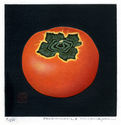
19th, 20th & 21st Century Fine Prints
707-546-7352 · fax 707-546-7924 · web: www.annexgalleries.com · email: artannex@aol.com
Haku Maki Biography
Haku Maki
Japanese
1924–2000
Biography
The artist was born with the name Maejima Tadaaki in 1924 in the small town Asomachi in the Ibaraki Prefecture of Japan. He graduated at Ibaraki Teachers' College and became vice-principal of an elementary school there. In 1945 he was in a special squadron of kamikaze pilots and his life was to be ended. However, with the surrender of Japan on August 14, 1945 his life was spared, and he became a teacher at a high school. He studied printmaking at the Modern Print Research Society with Koshiro Onchi andi, in 1950 he changed his name to Haku Maki. His work has a few characteristic design elements for which he became famous - deep embossing and the use of distorted Chinese characters.
Maki developed his own process of relief printmaking, applying mixed media printing techniques. The artist first carved a conventional woodblock. Then he put cement around the carved areas. When the cement had dried out, Haku Maki carved and chiseled the cement into the shape he wanted to have. Then a wet, double-layered paper was used for the printing. Thus prints made in this technique show strong embossing. Haku Maki's works look nearly three-dimensional. In 1969, Maki designed 21 block prints to accompany the book Festive Wine, ancient poetic songs from the 5th to the 9th century and published by John Weatherhill, Inc. His later works are composed of a broad range of variations on the use of calligraphic shapes.
In later life health problems made it often difficult for him to create his art works and he was assisted by his wife in the printing of the editions. Haku Maki died of cancer in 2000.






